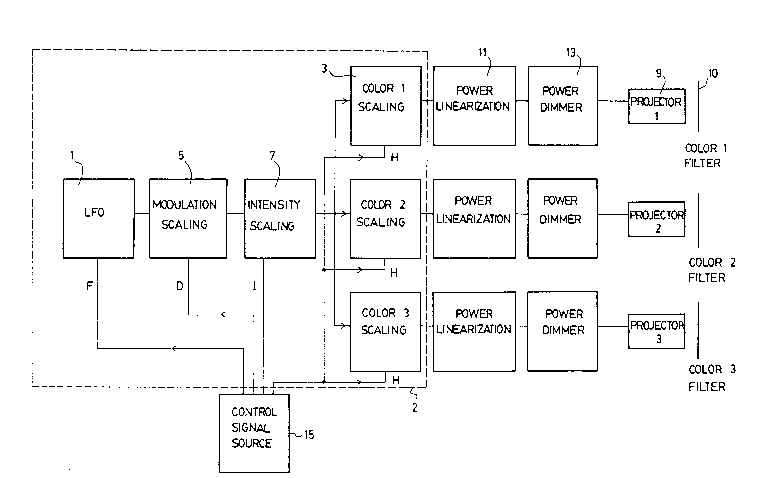Une partie des informations de ce site Web a été fournie par des sources externes. Le gouvernement du Canada n'assume aucune responsabilité concernant la précision, l'actualité ou la fiabilité des informations fournies par les sources externes. Les utilisateurs qui désirent employer cette information devraient consulter directement la source des informations. Le contenu fourni par les sources externes n'est pas assujetti aux exigences sur les langues officielles, la protection des renseignements personnels et l'accessibilité.
L'apparition de différences dans le texte et l'image des Revendications et de l'Abrégé dépend du moment auquel le document est publié. Les textes des Revendications et de l'Abrégé sont affichés :
| (12) Brevet: | (11) CA 2009302 |
|---|---|
| (54) Titre français: | SYSTEME DE MODULATION DE LA COULEUR ET DE L'INTENSITE DE LA LUMIERE |
| (54) Titre anglais: | LIGHT COLOR AND INTENSITY MODULATION SYSTEM |
| Statut: | Durée expirée - au-delà du délai suivant l'octroi |
| (51) Classification internationale des brevets (CIB): |
|
|---|---|
| (72) Inventeurs : |
|
| (73) Titulaires : |
|
| (71) Demandeurs : | |
| (74) Agent: | |
| (74) Co-agent: | |
| (45) Délivré: | 1994-09-13 |
| (22) Date de dépôt: | 1990-02-05 |
| (41) Mise à la disponibilité du public: | 1991-08-05 |
| Requête d'examen: | 1990-06-26 |
| Licence disponible: | S.O. |
| Cédé au domaine public: | S.O. |
| (25) Langue des documents déposés: | Anglais |
| Traité de coopération en matière de brevets (PCT): | Non |
|---|
| (30) Données de priorité de la demande: | S.O. |
|---|
There is disclosed a light color and intensity
modulation system having an output to be connected to a
color light projector and an input to receive a hue control
signal and an intensity control signal including at least
one modulation frequency component F. The system comprises
a color scaling device, receiving in use the hue signal,
the color scaling device producing a plurality of color
component signals, the plurality of color component signals
being supplied as the output to the color light projector,
and an intensity control device, receiving in use the
intensity control signal, the intensity control device
comprising a low frequency oscillator whose output is an
intensity modulation signal for varying an intensity of the
plurality of color component signals between a preset
minimum and a preset maximum value, the oscillator having a
frequency responsive to the at least one modulation
frequency component F of the intensity control signal, the
plurality of color component signals to control in use the
projector. The projected light can have a relaxing visual
effect.
Note : Les revendications sont présentées dans la langue officielle dans laquelle elles ont été soumises.
Note : Les descriptions sont présentées dans la langue officielle dans laquelle elles ont été soumises.

2024-08-01 : Dans le cadre de la transition vers les Brevets de nouvelle génération (BNG), la base de données sur les brevets canadiens (BDBC) contient désormais un Historique d'événement plus détaillé, qui reproduit le Journal des événements de notre nouvelle solution interne.
Veuillez noter que les événements débutant par « Inactive : » se réfèrent à des événements qui ne sont plus utilisés dans notre nouvelle solution interne.
Pour une meilleure compréhension de l'état de la demande ou brevet qui figure sur cette page, la rubrique Mise en garde , et les descriptions de Brevet , Historique d'événement , Taxes périodiques et Historique des paiements devraient être consultées.
| Description | Date |
|---|---|
| Inactive : Correspondance - TME | 2010-08-10 |
| Inactive : Périmé (brevet - nouvelle loi) | 2010-02-05 |
| Exigences pour le changement d'adresse - jugé conforme | 2008-02-08 |
| Déclaration du statut de petite entité jugée conforme | 2008-01-21 |
| Requête visant une déclaration du statut de petite entité reçue | 2008-01-21 |
| Demande visant la révocation de la nomination d'un agent | 2008-01-21 |
| Inactive : CIB de MCD | 2006-03-11 |
| Exigences pour le changement d'adresse - jugé conforme | 1999-12-10 |
| Inactive : Lettre officielle | 1999-12-10 |
| Inactive : Lettre officielle | 1998-05-14 |
| Inactive : Inventeur supprimé | 1998-05-14 |
| Inactive : TME en retard traitée | 1998-05-01 |
| Lettre envoyée | 1998-02-05 |
| Accordé par délivrance | 1994-09-13 |
| Demande publiée (accessible au public) | 1991-08-05 |
| Toutes les exigences pour l'examen - jugée conforme | 1990-06-26 |
| Exigences pour une requête d'examen - jugée conforme | 1990-06-26 |
Il n'y a pas d'historique d'abandonnement
| Type de taxes | Anniversaire | Échéance | Date payée |
|---|---|---|---|
| Annulation de la péremption réputée | 1998-02-05 | 1998-05-01 | |
| TM (brevet, 8e anniv.) - petite | 1998-02-05 | 1998-05-01 | |
| TM (brevet, 9e anniv.) - petite | 1999-02-05 | 1998-12-10 | |
| TM (brevet, 10e anniv.) - petite | 2000-02-07 | 1999-11-26 | |
| TM (brevet, 11e anniv.) - petite | 2001-02-05 | 2000-12-22 | |
| TM (brevet, 12e anniv.) - petite | 2002-02-05 | 2001-12-31 | |
| TM (brevet, 13e anniv.) - petite | 2003-02-05 | 2003-01-06 | |
| TM (brevet, 14e anniv.) - petite | 2004-02-05 | 2003-12-11 | |
| TM (brevet, 15e anniv.) - petite | 2005-02-07 | 2005-02-02 | |
| TM (brevet, 16e anniv.) - petite | 2006-02-06 | 2006-01-09 | |
| TM (brevet, 17e anniv.) - petite | 2007-02-05 | 2006-12-20 | |
| TM (brevet, 18e anniv.) - petite | 2008-02-05 | 2008-01-21 | |
| TM (brevet, 19e anniv.) - petite | 2009-02-05 | 2009-01-13 |
Les titulaires actuels et antérieures au dossier sont affichés en ordre alphabétique.
| Titulaires actuels au dossier |
|---|
| ALAIN MARTEL |
| Titulaires antérieures au dossier |
|---|
| S.O. |